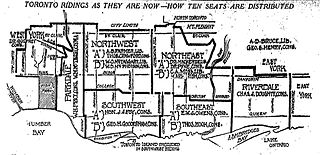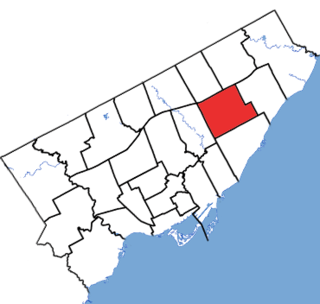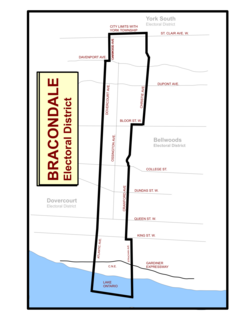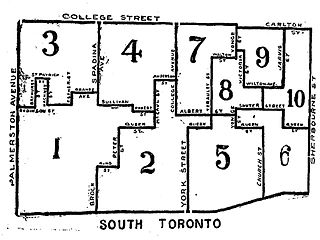
St. Andrew was a provincial electoral district in Ontario, Canada, that was established to elect Members of the Legislative Assembly (MLAs) and then Members of Provincial Parliament (MPPs) to the Legislative Assembly of Ontario.

Bellwoods was a provincial riding in Ontario, Canada in the old City of Toronto's west-end. It was represented in the Legislative Assembly of Ontario from 1926 until 1987, when it was abolished and redistributed into the Dovercourt, and Fort York districts.
St. Andrew—St. Patrick was a provincial electoral district in Ontario, Canada, that returned Members of Provincial Parliament (MPPs) to the Legislative Assembly of Ontario at Queen's Park.

Riverdale was a provincial riding in Ontario, Canada that existed from 1914 to 1999. It occupied an area east of the Don River from the city limits just north of Danforth Avenue south to Lake Ontario. It was named after the neighbourhood of Riverdale. In 1999 a major reduction in Ontario seats resulted in Riverdale being merged with part of East York into a larger riding called Broadview-Greenwood.
Downsview was a provincial riding in Ontario, Canada. It was created for the 1963 provincial election, and was retained until redistribution in 1999. Downsview was located in North York, which was previously part of Metropolitan Toronto and is now part of the City of Toronto. It was formed from part of the original riding of York Centre. In 1996 it was merged into a newly reconstituted riding of the same name.

Dovercourt was the name of a provincial riding in Ontario, Canada. It existed from the 1926 election to the 1999 election. When it was established, it bordered Brockton on to the west, York South to the north, and Bracondale on the east. Lake Ontario was its southern border for most of its existence. At its abolition in 1999, it consisted of that part of the city of Toronto bounded on the north by the former city limits, on the east by Bathurst Street, on the south by Bloor Street and on the west by the CN Railway and St. Clair Avenue. It was redistributed into Davenport, St. Paul's and Trinity—Spadina ridings.

Davenport is a provincial riding in Toronto, Ontario, Canada. It elects one member to the Legislative Assembly of Ontario.

York Centre is a provincial electoral district in Ontario, Canada, that has been the name of ridings in the Legislative Assembly of Ontario three different times. It was created initially in 1955 from the southern part of York North. It was dissolved in 1963 when it was split into three ridings called Yorkview, Downsview and Armourdale. In 1967, it was reconstituted north of Steeles in the township of Markham. This lasted until 1999 when it was dissolved into Markham—Unionville. The name was given to a new riding formed in its original location south of Steeles. It remains as an existing riding today.

St. George was a provincial riding in Ontario, Canada, that returned Members of Provincial Parliament (MPPs) to the Legislative Assembly of Ontario at Queen's Park. It was created in downtown Toronto in 1926 and was merged into the riding of St. George—St. David in 1987. The seat covered much of the city's central core, roughly similar to the current riding of Toronto Centre. At its dissolution it stretched from University Avenue to Parliament Street and from the waterfront north past St. Clair.

St. David was an Ontario provincial riding that existed from 1926 to 1987. It covered a section of the eastern city of Toronto east of Sherbourne Street and west of the Don River. The riding lasted until 1987 when it was merged with the neighbouring St. George to create a larger district called St. George—St. David.

Trinity—Spadina was a provincial electoral district in Ontario, Canada, that was represented in the Legislative Assembly of Ontario since 1999.

Parkdale—High Park is a provincial electoral district in Toronto, Ontario, Canada, created in 1996 and represented in the Legislative Assembly of Ontario since 1999. It is located in the Toronto's west-end, bordering on the lakefront to the south, the Humber River to the west, and the Canadian Pacific Railway tracks essentially defining its northern and eastern borders. There are 107,035 residents in the district. Federally the electoral district is held by Member of Parliament (MP) Arif Virani, provincially by Member of Provincial Parliament (MPP) Bhutila Karpoche and municipally by city councillor Gord Perks.

Scarborough Centre is a provincial electoral district in Ontario, Canada, that has been represented in Legislative Assembly of Ontario since 1963.

Bracondale was a provincial electoral district in Toronto, Ontario, Canada. It was represented in the Legislative Assembly of Ontario from 1926 to 1967. The constituency got its name from an old Toronto suburb called Bracondale, that was annexed by Toronto in 1909. Its most notable event was electing one of the first two women Members of the Provincial Parliament (MPP) to share the title "first-woman MPP" in 1943 when Rae Luckock was elected. In 1965, Bracondale's MPP, Joseph Gould, died in office sparking the final election held in the constituency. George Ben won the by-election, and became the constituency's last MPP. It was abolished for the 1967 Ontario provincial election, and redistributed into the Dovercourt and Bellwoods constituencies. As of 2012, the current electoral districts of Davenport, St. Paul's and Trinity–Spadina encompass this historic riding.

Parkdale was a provincial riding electing Members of Provincial Parliament (MPP) to the Legislative Assembly of Ontario. The riding was created from the western part of Toronto West riding in 1914 and abolished in 1996 and redistributed into the Parkdale—High Park, Davenport and Trinity—Spadina ridings for the 1999 Ontario general election.

Toronto Southwest was an Ontario provincial electoral district in the old City of Toronto's west-end. It was represented in the Legislative Assembly of Ontario from 1914 until 1926, when it was abolished and redistributed into the Brockton, Dovercourt, Bracondale, Bellwoods, St. Andrew, and St. Patrick districts. It had two seats in the Legislature: Seat A and Seat B.

Toronto Southeast was an Ontario provincial electoral district that existed from 1914 to 1926. It occupied an area south of College and Gerrard between University and Logan Ave. In 1926 there was a major redistribution of Ontario seats which resulted in Toronto Southeast being split between three new ridings called St. George, St. David, and Riverdale.
Scarborough East was a provincial electoral riding in Ontario, Canada. It was created prior to the 1963 provincial election and eliminated in 1996, when most of its territory was incorporated into the riding of Pickering—Scarborough East. Scarborough East riding was created from part of the former riding of York—Scarborough. It was in the former borough of Scarborough.

Toronto East, also known as East Toronto, was a provincial riding that was created in Toronto, Ontario when the country of Canada was established in 1867. At the time Toronto was divided into two ridings, East Toronto and West Toronto. In 1886, these ridings were dissolved and a combined riding of the entire city was created which elected three members. In 1894 this riding was split into four parts of which Toronto East was one. It occupied the eastern part of the old city of Toronto. From 1908 to 1914 it elected two members to the legislature. In 1914 the riding was abolished and reformed into two new ridings called Toronto Southeast and Riverdale.

Toronto South, also known as South Toronto, was a provincial riding that was created in Toronto, Ontario in 1894. In 1886, Toronto was represented as one entire riding that elected three members. In 1894 this riding was split into four parts of which Toronto South was one. It occupied the southern part of the old city of Toronto. From 1908 to 1914 it elected two members to the legislature. In 1914 the riding was abolished and reformed into two new ridings called Toronto Southeast and Toronto Southwest.









